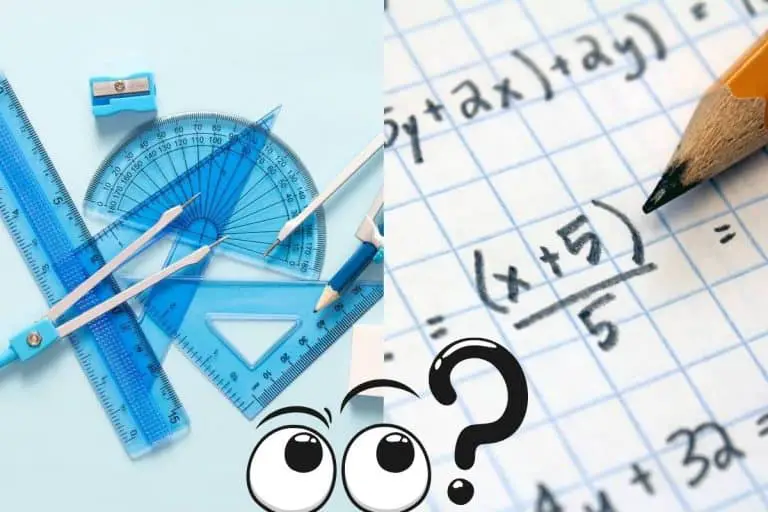Why Is Trigonometry So Darn Hard?
Most high school and college students hear the word Trigonometry and run away in fear. The course is known for being packed with complex concepts and challenging skills to master. But what makes it so hard?
Trigonometry is so darn hard because it requires students to build upon several subjects, including Geometry and Algebra. It involves critical thinking and complex problems, so students lack motivation to succeed because they believe it is impossible.
Though Trigonometry is challenging, it is not impossible. This article will cover why Trig is a difficult course, why it’s important to take, and how to succeed in the class.

Why Is Trigonometry So Difficult?
Trigonometry is so difficult because it requires critical thinking, mastery of earlier complex mathematical subjects, and motivation to study hard and learn new formulas and symbols.
Source: Journal of Physics
Trigonometry Requires Critical Thinking
Critical thinking is required for all math subjects. From the early years of school, teachers try to develop critical thinking in all their students as it is the number one precursor to academic success.
What is critical thinking?
To think critically, you need to question information, assess previous assumptions, and reflect. In other words, critical thinkers consider a problem or topic before forming their judgment, opinion, or answer.
With Trigonometry, that becomes an indispensable skill. It involves multi-step math problems that require extensive analysis to find a correct answer. Using your critical thinking skills might not always come naturally, which is why some students run into trouble with Trig.
Complexity
As you read earlier, Trigonometry involves concepts and skills from several other subjects.
Specifically, students need to be well-versed in the ideas from Algebra and Geometry. Those classes alone can be difficult for some students, making Trig’s meeting point that much more challenging.
It’s often difficult for students to connect multiple concepts, especially ones learned during different school years.
Often, Geometry and Algebra are taught in Freshman and Sophomore years, and then students have to remember those concepts from two years past and apply them to Trig. Last, Trig involves understanding visual diagrams and memorizing extensive vocabulary, which is challenging for most students.
Source: Georgia College and State University
Motivation
Motivation is often an issue for math students. Because the subject doesn’t always come naturally, you might have lower confidence when it comes to math. That’s especially true for Trig, which is a complex math class by itself.
If you go into Trigonometry with the belief that you won’t succeed, it’s much easier to fall into the trap of staying unmotivated.
Students who have limited interest and experience with a subject are much less likely to stay motivated to succeed. The good news is that there are a few recommendations to increase success in Trig.
How Can You Succeed in Trigonometry?
To succeed in Trigonometry, it’s crucial to embody a positive mindset, take advantage of your resources, and put in the most effort. You can also try some of these tips in and out of class:
- Take notes in class.
- Read and reread.
- Study for tests and quizzes.
- Do the homework.
- Visit during office hours.
- Work in groups.
You will find the most success in Trigonometry by doing the work in and out of class. Teachers assign homework that reiterates the information taught during class. When you work through those problems, you can increase understanding and cement that new information.
In addition, try visiting your teachers during office hours.
One-on-one instruction is always more beneficial than learning in a large class. You can ask your teacher some specific questions, bring up problems and challenging concepts, and get personalized instruction.
What Is Trigonometry?
Trigonometry is a form of mathematics that studies triangles and the relationships between their sides and angles. The study includes graphs, angle formulas, trigonometric functions, such as sine, cosine, and tangent, and the properties of triangles.
We see trigonometry show up in several different fields and real-life situations. Architects use trigonometry to study buildings. Doctors use trigonometry when assessing radiation, x-ray waves, and more. It’s also used in aviation and cartography.
When Do You Take Trigonometry?
Most high school students take Trigonometry during their junior year, but it can be taken earlier or later depending on the level of the student. In college, Trig is sometimes included within another math course like Pre-Calculus.
However, colleges and universities often have placement exams to determine which math classes students should take.
Trigonometry might be included in a college math placement or stand as its own placement exam. A student’s score on the placement exam will determine whether they should take Trig immediately or after other courses.
Students majoring in science, technology, and engineering courses will likely need to take Trigonometry in university. However, most other non-science majors can avoid the class by taking a general education math class.
What Classes Do You Need To Take Before Trig?
For high school students, Trigonometry class is usually placed after Geometry and before Calculus. Because Trig builds upon Geometry concepts and is used in Calculus, students take Geometry and Algebra 2 before Trigonometry and Pre-Calculus after.
Source: HSLDA Online Academy
You must take these challenging math courses strategically to get the most out of each class. In other words, the topics in earlier math classes give you essential skills and concepts to apply to Trigonometry and other later courses.
Topics from Algebra like solving equations and algebraic expressions come into play in Trigonometry. Similarly, a basic understanding of Geometry is vital for Trig, as they both cover triangles, the Pythagorean formula, and more spatial concepts.
Conclusion
Trigonometry is a challenging mathematics course built on concepts from Algebra and Geometry. The ideas and skills you learn in Trig are also essential understandings for Pre-Calculus and Calculus, in addition to science, technology, and math majors.
Students struggle with Trigonometry because of its complexity, the requirement of critical thinking, and a lack of motivation. However, you can excel in the course if you work hard in and out of class, use resources like study groups and office hours, and have confidence in your skills.
Recommended Reading:
Trigonometry vs. Calculus: Differences and Difficulty of Each







